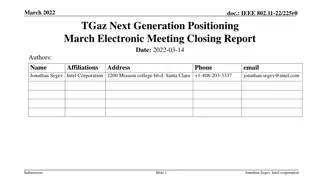The History of Stout Sudzers' March 2020 Meeting
The March 2020 meeting of Stout Sudzers delved into the origins of stout and porter beers, tracing back to London in the 18th century. The discussion explored the myths surrounding the invention of porter by Ralph Harwood and the evolution of malt roasting techniques by Wheeler in 1817. The presentation also highlighted the significant role of Arthur Guinness in popularizing porter through the St. James's Gate Brewery in Dublin. Discover the rich history and brewing innovations that have shaped these beloved dark beers.
Download Presentation

Please find below an Image/Link to download the presentation.
The content on the website is provided AS IS for your information and personal use only. It may not be sold, licensed, or shared on other websites without obtaining consent from the author.If you encounter any issues during the download, it is possible that the publisher has removed the file from their server.
You are allowed to download the files provided on this website for personal or commercial use, subject to the condition that they are used lawfully. All files are the property of their respective owners.
The content on the website is provided AS IS for your information and personal use only. It may not be sold, licensed, or shared on other websites without obtaining consent from the author.
E N D
Presentation Transcript
History of Stout Sudzers March 2020 meeting
Starts with Porters - John Felthman, guidebook The Picture of London , published 1802, wrote that Ralph Harwood invented ported in 1722 in London - Porter replicated Three Threads : blend of three separate beers, consisting of one third each beer, ale*, and strong beer , mixed at bar at point of service - Entire or Entire-butt since the whole thing was served from one cask - Workingman s pint of choice , which may be the reason for the name porter *probably refers to a drink made without hops https://www.anchorbrewing.com/blog/porter-the-entire-history/ http://zythophile.co.uk/false-ale-quotes/myth-one-ralph-harwood-invented-porter-as-a-substitute-for-three-threads/
Or, maybe not... http://zythophile.co.uk/false-ale-quotes/myth-one-ralph-harwood-invented-porter-as-a-substitute-for-three-threads/
Another story - No previous writer in the 80-plus years since porter had first appeared had ever said the drink was an attempt to imitate another, mixed beer. Nor, apart from one brief attempt in 1788, almost 70 years after the event, had anyone before claimed Harwood of Shoreditch as the inventor of porter. - John Tuck Private Brewer s Guide to the Art of Brewing Ale and Porter , published 1822 - London s brewers. who sold a heavy and glutinous brown beer, started to come under pressure from the brewers of paler beers which were popular with the country gentry now buying themselves houses in the capital. - About 1720., Tuck said, London s brewers brought out an improved brown beer started, well hopped, into butts, and kept a considerable time to grow mellow. http://zythophile.co.uk/false-ale-quotes/myth-one-ralph-harwood-invented-porter-as-a-substitute-for-three-threads/
Improved malts - Wheeler s invention of the malt roaster in 1817 made black malt available for the first time - Previously, grains were floor malted; typically smoked due to the fuel source below the floor; inconsistent - Wheeler s invention used a rotating metal drum; inspired by coffee makers - Allowed for more control over the time and temperature, and gave rise to many new malts https://www.anchorbrewing.com/blog/porter-the-entire-history/ https://beerandbrewing.com/dictionary/QPuJzcZGJq/
Guinness - 1759; Arthur Guinness signed a lease for the St. James s Gate Brewery in Dublin for 9000 years at an annual rent of 45 - 1770 s started brewing porter, Porter was different from ale because it was brewed using roasted barley, giving the beer a dark ruby colour and rich aroma. - 1799, porter was so popular that he stopped brewing ale altogether - Arthur Guinness brewed different types of porter to suit different tastes, including a special export beer called West India Porter . This beer is still brewed today and is now known as GUINNESS Foreign Extra Stout. - Interesting to note that the Guinness website credits Harwood with the creation of porter https://www.guinness-storehouse.com/content/pdf/archive-factsheets/general-history/company-history.pdf
Porters and stouts I [Bob Brewer, Anchor] asked for a simple clarification of the stylistic difference because I considered it to be one of the more confused and ill-defined. Michael [Jackson] s reply was that it was actually the MOST confused and ill-defined. He furthermore stated that even the best-researched and well-intended writings on the subject were as unambiguous as a horoscope. https://www.anchorbrewing.com/blog/porter-the-entire-history/
Porters and stouts Historically speaking, the first of the two styles was porter, born about 300 years ago from the English brown ales of the time. Stouts came after, as stronger, fuller-bodied versions of porters, aka stout porters. When a pub offered both a stout and a porter, stout was always the stronger beer. https://www.allagash.com/blog/stout-vs-porter-whats-the-difference/
BJCP 2015 styles Style Description 15B. Irish Stout Roasty, coffee, bitter chocolate, similar to Irish Extra Stout but lower ABV 15C. Irish Extra Stout Fuller bodied, bittersweet to bitter, between Irish Stout and Foreign Extra Stout 16A. Sweet Stout Full body, slightly roasty, coffee-and-cream or sweetened espresso , lactose 16B. Oatmeal Stout. Full body, roasty, malty, sweet/bitter balance can vary; cross between 15C+16A 16C. Tropical Stout Dark, sweet, fruity, smooth roast, no burnt harshness, warm fermented lager yeast, like a scaled-up sweet stout with higher fruitiness 16D. Foreign Extra Stout Fairly dry, prominent roast flavors, not as bitter as American Stouts 20B. American Stout Highly roasted, more aggressive American hop character and bitterness 20C. Imperial Stout Like a black barleywine , intensely-flavored , roasty, burnt, warming
Russian Imperial Stout - 18th&19th century, British breweries exporting dark beer to Baltic ports, and from that, we got the RIS and Baltic Porters, both much higher ABV versions of the original porters and stouts - Though the history of imperial stout is somewhat murky, it was indeed a London brewery that is credited with popularizing the style as a strong, exported stout. Around 1781, Barclay Perkins began exporting its stout to assorted ports in the Baltic region. Purposely brewed to be a formidable beer, it would easily withstand the voyage. - When Empress Catherine II discovered it, its place in Russian legend was cemented. The commercial viability of the brew ensured that the style endured. - Today, under the name of Courage, the same imperial stout is still brewed in London. http://allaboutbeer.com/article/imperial-stout-4/
Tropical Stout - A style born in the West Indies (mostly the Caribbean) and West Africa - Before 2015 BJCP guidelines, it was a subcategory of Foreign Extra Stout - The style originated from the British exporting Porter to the English colonies in the Indies - by 1801 Guinness was brewing their West Indies Porter and it was being exported into Barbados, Trinidad and the rest of the Caribbean. (probably a stout porter) - Local brewers in the Caribbean, and then Africa, started making their own - A tropical stout makes use of indigenous grain and adjunct sugars where possible and, because most of these hot clime breweries are heavily committed to lager brewing, this style often uses lager yeast, instead of the usual ale yeast. - Less hops were used in local versions https://learn.kegerator.com/tropical-stouts/























